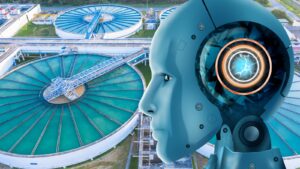‘New-Master-Planned Cities’ are in the spotlight when it comes to urbanisation in Australia. These are uniquely designed to serve the fusion of modernity and high levels of living spaces with sustainability. Though the concept has gained popularity due to its excellent outcome, there are many challenges encountered from its planning to processing. That is where the construction companies have to rely on new-age innovation. Artificial Intelligence or AI technology is one pillar that entered the scenario of new-master-planned cities to provide the ‘all-in-one’ solution.
In our blog article, we delve into AI technology and its employment in the new-master-planned-cities concept. Also, we are going to explore how this technology becomes the best answer to all the obstacles in urbanisation.
What is AI Technology?

It is a combination of technologies that provide computers the capacity to carry out a range of sophisticated tasks, such as understanding and interpretation of language, the analysis of data, the creation of suggestions, and more. If put in simple words, AI is the engine of innovation in current computing, bringing out possibilities for businesses.
AI is mostly based on advanced algorithms such as machine learning and deep learning to look deeper into various tasks. These tasks range from data analytics, forecasting, object classification, natural language processing, and recommendations to intelligent data retrieval, etc.
The capacity of AI lies between the reason for doing it and its execution actions in the highest quality. AI is highly powerful because there are computer systems that can automatically learn from and adapt to new data without human interference.
3 Key Obstacles in Building New-Master-Planned Cities

No Link Between Different Construction Aspects
In the creation of new master-planned communities, the lack of a unifying connection between various building components is undoubtedly a significant challenge. Infrastructure, residential areas, business areas, and public services must all reside together smoothly in these complex city developments.
Lack of coordination and communication between these components can result in inefficiencies, inefficient land usage, and higher expenses. If we take an example, poor coordination between housing development and transportation planning can raise unwanted traffic jams and eventually lead to decreased accessibility.
Enough Amount of Resource Allocation
These large-scale initiatives require major investments in infrastructure, utilities, etc. The challenging part here is, finding and allocating the right amount of resources at the right times. It is important to strike a balance when allocating resources between pressing needs and long-term sustainability projects. When the new-master-planned cities are concerned, their infrastructure can be completely different from the other projects that already exist.
Traditional methods and manual work might not be enough for the authorities to execute such advanced projects. That is where innovations and creative solutions are important. Also, when you employ advanced technology, you need a workforce who is knowledgeable to work with these tools. That can be challenging more than you predict.
Balancing Environmental Aspects
As we mentioned before, nowadays, urban initiatives try to be mindful of the environment, sustainable, and lasting. It can be difficult to balance fast development and environmental preservation, though. On one hand, the authorities must take care of the usefulness of these cities and productivity; on the other hand, they need to focus on the creation of green areas, the use of renewable energy sources, and the promotion of environmentally friendly transportation methods within the new cities.
Also, how can we ignore the requirement for strengthening resilience against the effects of rapidly changing climate conditions? These types of changes add another level of complexity.
How to Optimise New-Master-Planned Cities with AI Technology

Smart Infrastructure Management
When they are implementing IoT sensors and AI-driven systems, cities can monitor and manage critical infrastructure components like energy grids, water supply, waste management, and transportation networks with unparalleled efficiency. These systems continuously collect and analyse data, providing real-time insights into infrastructure performance. One significant advantage is the use of predictive maintenance algorithms.
These algorithms can anticipate equipment failures and deterioration trends, allowing for proactive maintenance interventions. This optimisation reduces downtime, extends the lifespan of infrastructure assets, and ultimately leads to cost savings for the city. The best thing about this technological application is that Incorporating smart infrastructure management not only enhances the reliability of essential services but also contributes to the overall sustainability and resilience of the city.
Data-Driven Utility Planning
Data-driven utility planning, empowered by AI technology, offers high levels of benefits when it comes to city planning. You know that AI is capable of analysing vast datasets and incorporating sophisticated algorithms. This capacity of AI enables urban planners to make informed decisions regarding the deployment and management of utilities such as water, electricity, and gas in their newly established cities.
When the planning is coupled with AI technology, it can optimise resource allocation and enhance infrastructure efficiency. This strategic approach ensures that utilities are delivered reliably to meet the needs of a growing population. Another major benefit is that AI-driven predictive analytics can estimate future utility consumption patterns and potential supply disruptions in the cities, which is highly beneficial to find solutions in advance.
Traffic Management Planning
This robust technology brings significant advantages to traffic management planning in these new city developments. Authorities can benefit from the deployment of AI-powered traffic management systems to streamline transportation inside cities. They can improve overall transportation efficiency, reduce traffic jams, and improve traffic flow accordingly. As circumstances change, these systems use real-time data to modify traffic lights and routing, ultimately cutting travel times and decreasing jams.
Again, AI is introducing autonomous vehicles and smart public transportation systems to the new planned cities. This is known as an innovative way to improve accessibility and decrease the environmental impact of the cities.
Land Suitability Inspections
Conducting land suitability inspections is one important aspect when it comes to new city planning projects. The latter extends its assistance to fulfil this requirement without any barriers. AI algorithms and remote sensing technologies can provide various facts about the chosen land for the city projects. Construction companies can efficiently evaluate vast tracts of land to determine their suitability for various purposes, such as residential, commercial, or green spaces.
This sophisticated software can analyse factors like soil quality, terrain, environmental constraints, and proximity to existing infrastructure with speed and precision. This enables urban planners to make data-driven decisions, optimising land allocation and ensuring that development aligns with the city’s goals for sustainability.
Enhancing Energy Efficiency
Cities could enhance the equal distribution of electricity by incorporating AI into their energy systems in the first place. Another benefit is the software can control supply and demand, cut waste, and encourage the seamless integration of renewable energy sources. It is evident that installing AI-driven building management systems allows for exact energy consumption control in both residential and commercial constructions in the cities.
These systems are able to adjust to user habits and external factors, maximising the effectiveness of heating, cooling, and lighting systems. So, what is the outcome? It enables cities to reduce operating expenses and their carbon footprint while also assuring the sustainable use of energy resources inside the new planned city.
Witness New Age of Development with Smart Technology

Development is the heart of the modern world, and it is visible that businesses encounter various obstacles when embarking on these new development projects. Technology is something that you can make the pillar of strength when seeking the best solution for them. However, it is also important to conduct thorough research before purchasing any software solution, as not every technology can provide the best. Collaborating with the industry expert is our friendly advice for you as a solution.







